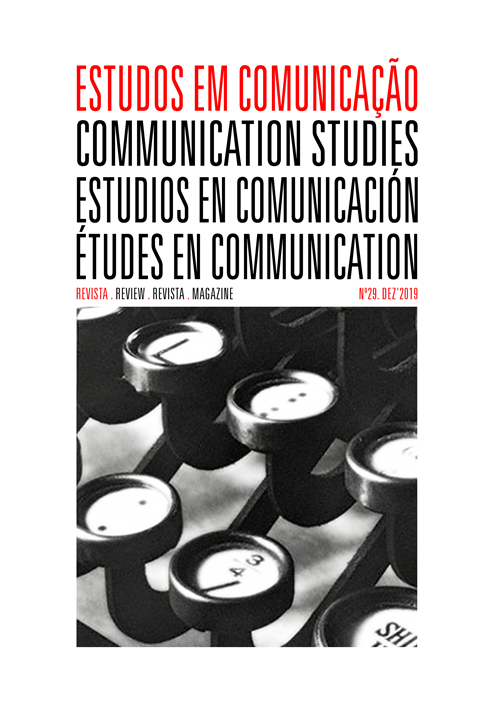Representations about the application of online dating Tinder in the media. A longitudinal analysis of the Portuguese written press between 2012-2017
Keywords:
Tinder, online dating, framing, agenda setting, pressAbstract
This article presents the results of a study which the purpose was analyzing and understanding the attention and framing, given by the media, to the topic of online dating through the app Tinder, between 2012 and 2017, in three Portuguese newspapers – Correio da Manhã, Diário de Notícias and Observador. The analysis mobilized quantitative techniques, through the collection of bibliographic variables, and qualitative techniques through the content analysis of articles that approached the theme. Concerning agenda setting, the results indicate a limited number of exclusive pieces about the app or their users, most of which arises as a reference or about differences in relationships of different epochs. In terms of framing, is conditioned by the editorial line quite present in the analyzed articles.
References
Banks, M. (2001). Visual Methods in Social Research. Londres: Sage.
Baym, N. (2011). Personal Connections in the Digital Age. Polity Press Bell.
Bourdieu, P. (1996). On Television. New York: The New Press.
Boyd, D. (2010). Social Network Sites as Networked Publics: Affordances, Dynamics, and Implications.
In Z. Papacharissi, Networked Self: Identity, Community, and Culture on Social Netwok Sites (pp. 39-58).
Castells, M. (2009). Communication Power. Oxford: Oxford University Press.
Chambers D. (2013). Social Media and Personal Relationships – Online Intimacies and Networked Friendship. Hampshire: Palgrave Macmillan.
Cohen, B. (1963). The press and foreign policy. Princeton: Princeton University Press.
Cohen, S. (2011). Folk Devils and Moral Panics. Londres: Routledge.
Correia, J. (2016). Prefácio. In A. Gradim, Framing. O enquadramento das notícias. Lisboa: Livros Horizonte.
Couldry, N. (2012). Media, Society, World: Social theory and digital media practice. Cambridge: Polity.
Croteau, D. & Hoynes, W. (2014). Media/Society: Industries, Images and Audiences. Londres: Sage.
Curran, J. & Seaton, J. (2003). Power Without Responsibility. Londres: Routledge.
Entman, R. (1993). Framing: Toward clarification of a fractured paradigm. Journal of Communication, 43(4): 51-58.
Entman, R. (2004). Projections of Power: Framing News, Public Opinion, and US Foreign Policy. Chicago, IL: University of Chicago Press.
Gitlin, T. (1980). The Whole World Is Watching: Mass Media in the Making and Unmaking of the New Left. Berkeley: University of California Press.
Goffman, E. (1974). Frame analysis: An essay on the organization of experience. Boston: Northeastern University Press.
Gunter, B. (2000). Media Research Methods, Measuring Audiences, Reactions ans Impact. Londres: Sage.
Hall, S. (2005). The rediscovery of ‘ideology’: return of the repressed in media studies. In T. Bennett, et al. (eds.), Culture, Society and the Media (p. 60). London & New York: Routledge, 2ª edição.
Harrison, J. (2010). Gatekeeping and News Selection as Symbolic Mediation. In S. Allan, The Routledge Companion to News and Journalism (pp. 191-201). Londres: Routledge.
Hjarvard, S. (2012). The study of news production. In K. Jensen, A Handbook of Media and Communication Research: Qualitative and Quantitative Methodologies (pp 87-105). London & New York: Routledge.
Hodgetts, D. & Chamberlain, K. (2014). Analysing News Media. In U. Flick, The Sage Handbook of Qualitative Data Analysis. Londres: Sage.
Hodkinson, P. (2017). Media, Culture and Society. An Introduction. Londres: Sage, 2ª edição.
Jensen, K. (2012). A Handbook of Media and Communication Research: qualitative and quantitative methodologies. Londres & New York: Routledge, 2a edição.
Litt, E. (2012). Knock, knock. Who’s There? The imagined audience. Journal of Broadcast & Electronic Media, (56): 330-345.
Litt, E. & Hargittai, E. (2016). The Imagined Audience on Social Network Sites. Social Media + Society.
Mccombs, M. & Shaw, D. (1972). The agenda-setting function of mass media. Public Opinion Quarterly, 36: 176-187.
Rebelo, J. (2002). O discurso do Jornal. O Como e o Porquê. Lisboa: Notícias Editorial, 2ª edição.
Reese, S. (2001). Prologue – Framing Public Life: A Bridging Model for Media Research. In S. Reese (ed), Framing Public Life: Perspectives on media and our understanding of the social world. New Jersey: Lawrence Erlbaum.
Rose, G. (2001). Visual Methodologies: An Introduction to the Interpretation of Visual Materials. Londres: Sage.
Saldaña, J. (2009). The Coding Manual for Qualitative Researchers. Londres: Sage.
Schudson, M. (2003). The Sociology of News. New York: W. W. Norton & Company.
Shoemaker, P. (1991). Gatekeeping. Londres: Sage.
Silverstone, R. (1999). Why Study the Media. Londres: Sage.
White, D. (1950). The ‘Gate keeper’: A Case Study in the Selection of News. Journalism Quaterly, 27(4): 383-390.
Downloads
Published
Issue
Section
License
Estudos em Comunicação/Communication Studies is an Open Access journal. All its content is freely available without charge to the user or his institution. Users are allowed to read, download, copy, distribute, print, search, or link to the full texts of the articles in this journal without asking prior permission from the publisher or the author. Estudos em Comunicação, by Labcom, is licensed under a Creative Commons Atribuição-NãoComercial-SemDerivações 3.0 Unported License. By submitting your work to Estudos em Comunicação/Communication studies you confirm you are the author and own the copyright, that the content is original and previously unpublished, and that you agree to the licensing terms.


